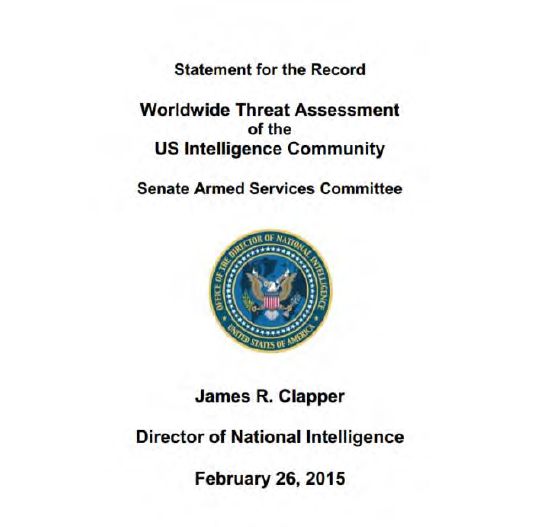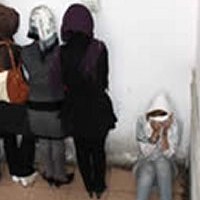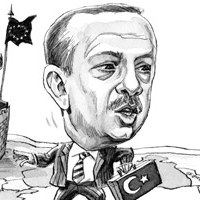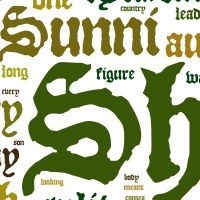![]()
Sunday, March 15, 2015
This article was originally published by ITIC.
Overview
On February 26, 2015, US Director of National Intelligence (DNI) James R. Clapper presented the members of the Senate Armed Services Committee with the Worldwide Threat Assessment of the US Intelligence Community.

Worldwide Threat Assessment of the US Intelligence Community for 2015: Iran and Hezbollah are not mentioned in the list of terrorist threats.
The Threat Assessment for 2015 was presented at a time when the United States heads an international coalition leading an attack against ISIS in Syria and Iraq. Indeed, in the Threat Assessment for 2015, emphasis is clearly placed on the American campaign against Sunni-jihadi terrorism (whose most prominent representatives are ISIS and Al-Qaeda). Conversely, the head of the DNI does not mention the threat of Shiite terrorism, including the challenges of terrorism from Iran and Hezbollah. In this context, Hezbollah is not mentioned (apart from a single reference, stating that it supports the Lebanese Army against the “leakage” of Sunni terrorism from Syria). Iran itself is mentioned in other contexts as a country that constitutes a substantial and diverse challenge (cyber, espionage, arms control) while engaging in its nuclear program.
The lack of references to the threat of Iranian and Shiite terrorism contradicts previous publications by US government agencies (the Intelligence Community and the State Department) in 2014, which stated that Iran and Hezbollah continued to directly challenge the interests of US allies and that Hezbollah had increased its global terrorist activity in recent years to a level not seen since the 1990s (see Appendix A).
In the ITIC’s assessment, the lack of reference to the Shiite terrorist threat, and Iran and Hezbollah as its generators, is not accidental.The ITIC believes that this is due to a combination of political considerations (the US dialogue with Iran over the nuclear agreement) and the idea that Iran and Hezbollah may be of assistance in the campaign against ISIS in Syria and Iraq and possibly in other countries (Iran is mentioned together with the United States, the West and the Arab countries as confronting ISIS). Under these circumstances, the US prefers to downplay Iran’s use of the “terrorist weapon” (including the massive support that it provides to Hezbollah and its use of the latter to advance its own strategic goals in the face of Israel and the entire region).
It should be noted that in contrast to the review by the head of the DNI, the Qods Force and Hezbollah do appear on the DIA’s list of terrorist threats, although it seems they are mentioned in the report in rather weak terms. In the list of global threats[1] presented to Congress by DIA Director Vincent R. Stewart (February 3, 2015), Iran and Hezbollah are mentioned on the list of terrorist threats. The chapter “Terrorism” is devoted primarily to Al-Qaeda and ISIS, while Iran and Hezbollah are mentioned laconically:
“Islamic Revolutionary Guard Corps-Qods Force (IRGC-QF) and Lebanese Hizballah are instruments of Iran’s foreign policy and its ability to project power in Iraq, Syria, and beyond. Hizballah continues to support the regime of Syrian President Asad, pro-regime militants and Iraqi Shia militants in Syria…”
In practice, Iran remains a country that sponsors terrorism and perceives terrorism and subversion as a main tool for promoting its policy and its interests in the Middle East. The Iranian regime, by means of the Qods Force, an elite unit of the Revolutionary Guards, allocates significant resources in the form of money, high-caliber manpower and weapons to support terrorist organizations in the Middle East, the most prominent of which is Hezbollah. Past experience has proved that acts of terrorism and subversion promoted by Iran are not limited only to the Middle East, but are carried out in many countries around the world. In the ITIC’s assessment, as Iran’s self-confidence grows, especially if it feels that it has made achievements with the United States in the negotiations over its nuclear program, it is liable to increase the scope of its support to terrorism and its daring use of terrorism and subversion in the Middle East and around the world.
![]()
Assessments of terrorist threats in US government publications in 2014
Worldwide Threat Assessment of the US Intelligence Community for 2014
“Iran and Hizballah — Outside of the Syrian theater, Iran and Lebanese Hizballah continue to directly threaten the interests of US allies. Hizballah has increased its global terrorist activity in recent years to a level that we have not seen since the 1990s.”
Assessment of the terrorist threat in the annual report of the US Department of State (Country Reports on Terrorism, April 2014)
“In 2013, Iran’s state sponsorship of terrorism worldwide remained undiminished through the Islamic Revolutionary Guard Corps-Qods Force (IRGC-QF), its Ministry of Intelligence and Security, and Tehran’s ally Hizballah, which remained a significant threat to the stability of Lebanon and the broader region. The U.S. government continued efforts to counter Iranian and proxy support for terrorist operations via sanctions and other legal tools. The United States also welcomed the EU’s July 2013 designation of Hizballah’s military wing as a terrorist organization.”
![]()
Appendix B
Comparison between the Worldwide Threat Assessments of the US Intelligence Community for 2015 and for 2014
| Assessment for 2015 | Assessment for 2014 | |
|---|---|---|
| Threats on homeland security |
|
|
| Threats from outside the United States |
|
|
| Iran and Hezbollah |
|
|
![]()
[1] Worldwide Threat Assessment, February 3, 2015, DIA website.



 RSS
RSS










Latest Comments
Hello Mike, Thank you for your positive feedback to the article. I felt there wasn’t too much critical analysis of ...
Thanks for this considered and well constructed article. A follow up article on the manner in which the editorial contro...
THE CLUELESSNESS OF CLAIMING THAT OBAMA'S MIDDLE EAST POLICIES WERE A FAILURE CANNOT BE FURTHER FROM THE TRUTH, WHAT THE...
As long as Obama is the president of the usa do not trust the us government......
Thank you for an good read....